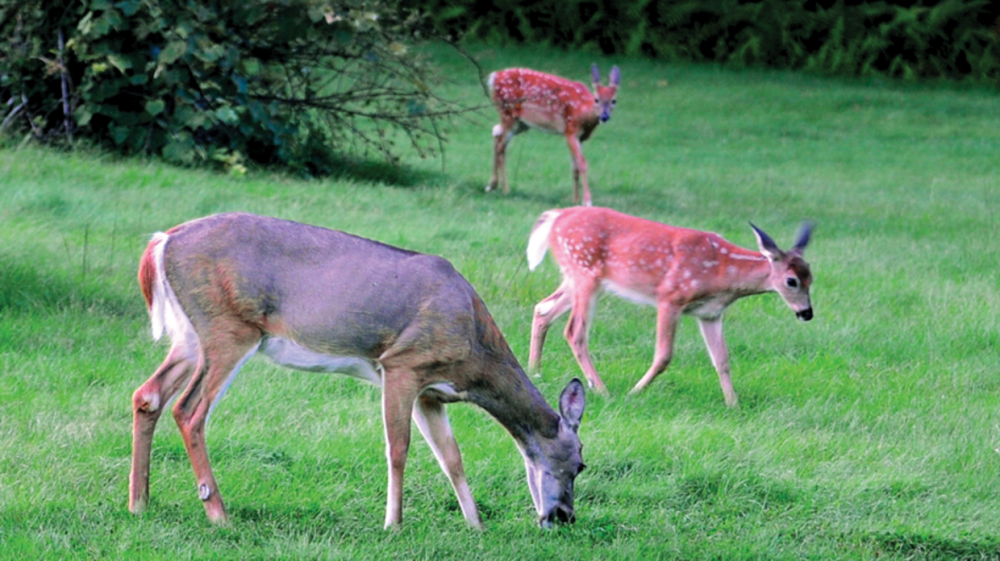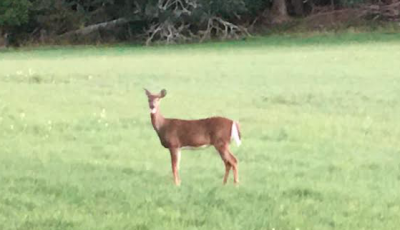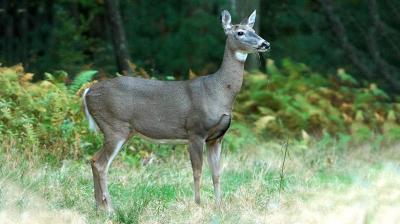They’re a dear sight, but deer in road pose dangers
The same vistas that make Dartmouth appealing to residents — open fields, orchards, wooded areas abutting homes — also attract deer, wildlife officials report.
When the animals are viewed from a distance, they can add to the charm of the community. But when deer and vehicles collide, the results can be devastating to deer and dangerous for motorists.
Twelve crashes involving deer were reported in Dartmouth in 2020, according to Mark Schieldrop, spokesperson for AAA Northeast. One involved a non-fatal human injury.
Of the 12 crashes, half took place in a three-month period of October, November and December.
Fall is the breeding season for white-tailed deer, which can be particularly active during early morning and evening hours, said Marion Larson, chief of information and education for MassWildlife.
This time of year also coincides with reduced amounts of daylight.
During the breeding season, the deer can and often do dart out, Schieldrop said. “Suddenly there’s a deer looking right at you,” he said.
Deer inhabit wooded areas and fields where they have access to berries and other food sources, making them frequent sights in the more rural areas of town.
But they can be found anywhere in town, Dartmouth Police Officer Joseph Vieira said. Deer have been seen in the Bliss Corner area and around Jones Beach, areas of Dartmouth that are more densely populated than much of town and which are not far from the New Bedford line.
Massachusetts drivers are at medium risk of collision, with the odds of striking an animal listed by State Farm Insurance at 1 in 107. Massachusetts is rated 28th among the 50 states for animal strike risk.
There have only been 2 human fatalities reported in Massachusetts as the result of deer strikes, Larson said. Coincidentally, both accidents involved similar circumstances: The deer was struck by a car, flipped over the median/lane and then crashed into an oncoming second vehicle.
In both cases, one on Beverly, the other in Weston, the driver of the second vehicle was killed.
The best way to avoid deer strikes, experts advise, is to stay alert and aware of your surroundings.
That can be challenging, Vieira said, when “people are distracted in their vehicles to begin with’’ with “seven-inch screens’’ and automatic driving functions such as cruise control competing for their attention.
To reduce chances of strikes, make sure all exterior lights are clean so they can perform at maximum capacity. High beams are recommended when possible.
“Every little bit of light that helps you see forward gives you a better chance of missing an object,’’ Vieira said.
Keep your eyes ahead at all times, he said. “You should be looking to the horizon at night,’’ he said. “If you see lights in your headlights, it’s likely an animal.’’
Be aware that if you see one deer, others may follow, Vieira said. And be cognizant of how quickly they can move. “They’ll dart out,’’ he said.
That awareness is crucial, Schieldrop said. “If you say you’re going to be on the lookout for deer, your brain is more likely to notice them or see them in your peripheral’’ vision, he said.
If you do encounter a deer, “try not to panic,’’ Schieldrop said.
Reduce your speed, honk your horn and tap your brakes to alert other drivers, Larson said. If there are no other drivers behind you, brake hard, she advised.
Swerving can be a natural inclination, Schieldrop said, but that can lead to a worse outcome.
“Brace yourself and slow down,’’ he said. No one wants to hit an animal, he said, but sometimes that outcome is inevitable and less dangerous to the driver than swerving and striking a tree, for example.
And don’t drop your guard in more urban areas, he said. Deer can be found where you least expect them.
Even in urban areas, he said, “our landscaping is delicious.’’
Being aware can save your life and that of the deer. “Anticipating and knowing [a strike] could happen at any moment is a great defense,’’ he said. “Even a few milliseconds’’ can make a difference.














